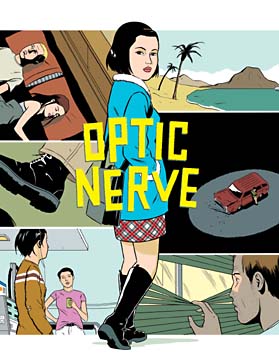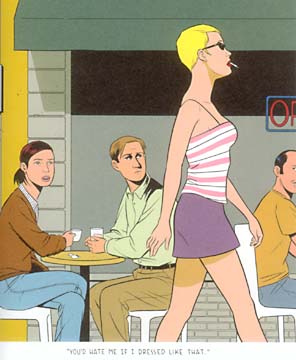
Graphic Arts As Literature

|
A little too close to home
A comic book writer and illustrator
reveals his life in his acclaimed work
There's no one who captures the ennui of his generation better in comic book form than 30-year-old Adrian Tomine.
His biography in brief: The Sacramento, Calif.-born writer and illustrator went through the usual childhood superhero phase before he discovered the rich and masterful storytelling of brothers Gilbert and Jaime Hernandez in their independent series "Love and Rockets." Inspired by their work, Tomine started doing comics work in a fictional and autobiographical vein while still in high school in the early 1990s.
It was then that he started his series "Optic Nerve," which started as a mini-comic and continues as a flagstaff title for Drawn & Quarterly, the fine independent publisher based in Montreal, Canada. In 1992, he was hired by Pulse! magazine, the defunct publication of the Tower Records chain, to produce a monthly comic strip.
These strips, plus an extensive selection of his illustrations and design work for magazines, record labels and music acts, were collected and released last month in "Scrapbook." It's here that you see the development of a fledgling 16-year-old illustrator to his current stature as one of the most distinctive and elegant writer/illustrators in the comics field today.
In a recent e-mail interview with Tomine, who splits his time between Berkeley, Calif., and Brooklyn, N.Y., he admits that "Scrapbook" may not be the perfect entry point into his work. It might be better to pick up his collections "32 Stories" (from his earlier mini-comics), and "Sleepwalk" and "Summer Blonde," two books that compile the last two story arcs from his "Optic Nerve" series.
Tomine wrote in a joking, self-deprecating way that "Scrapbook" is "a 200-page testament to the power of egotism."

|
EVEN THOUGH Tomine admits "I'm really embarrassed by a lot of the older material, but because it's so old, there's a distance that allows it to be palatable to me," I think he's his own worst judge. Several highlights from his "Scrapbook" include strips about a break-up based around the music of the Pixies, his peer pressure "romance" of "My First Girlfriend" and a hilarious encounter with actor Gedde Watanabe that was first published in the Asian-American pop culture magazine Giant Robot.
But he's right that his black-and-white "Optic Nerve" book is the best place to get acquainted with his superb work. After receiving both critical and reader accolades for his "Sleepwalk" and "Summer Blonde" story lines, his latest story-in-progress, "White on Rice," began in his latest issue.
The story is developing into a study of the consequences of a long-distance romance between two young Asian-Americans -- she moves to New York City for an internship with a film institute, and he's the boyfriend who manages a film art house in Berkeley. Figure in a mutual lesbian friend, and a potential love interest in a cute (white) teenager that works at the theater, and you've got an intriguing story told in Tomine's inimitable, observant style.
But is life imitating art? There was a two-year gap between issues 8 and 9 of "Optic Nerve," and when asked if the core of the relationship addressed in "White on Rice" mirrored what was going on in his life, Tomine agreed -- to a certain extent.
"The main cause for the delay between issues was simply the decision to try to conceive of a longer, multi-issue story. I felt it was important to get the whole story fairly well worked out before starting, so just the planning alone took a long time. But ironically, life did imitate art in some ways, with bad events in my real life occurring virtually simultaneously to the events in the comic as I was drawing them.
"At one point, I thought about just departing from my script completely and having the main character suddenly win the lottery," he said.
THERE'S A palpable element of cinematic pacing in his work, and Tomine said that "I think the most obvious cinematic inspiration for this story in particular is Woody Allen, especially films like 'Husbands and Wives,' 'Crimes and Misdemeanors' and 'Manhattan.' ... Some other movies I really like are 'Lolita' (the Kubrick version, of course), 'Crumb,' 'Blue Velvet,' 'Adaptation' and 'The Ice Storm.' "
Besides his work on "Optic Nerve," Tomine is also working on a multi-volume project featuring the work of the great Japanese cartoonist Yoshihiro Tatsumi, which dates to the '50s.
"He pioneered a style of Japanese comics called 'gekiga,' which tends to focus on the grim realities of modern life. He's been a favorite of mine for many years, and a big inspiration. There was one English edition of his work published in the '80s, but it was poorly done, and hardly comprehensive. So just as a fan, I've wanted to see more of his work properly translated for a long time now."
A few years ago, he presented samples of Tatsumi's stories to Chris Oliveros at Drawn & Quarterly, and together they tried to procure the rights to Tatsumi's work.
"It was a long and difficult process," Tomine wrote, "but we eventually got everything nailed down, and when I went to Japan last year, I had the opportunity to meet with Mr. Tatsumi. So we're slowly working on the first volume, and I think it should be released early next year.
"I will be serving as the designer and editor of the project (and) I hope people will buy it, because it deserves to be read, and I think it will appeal to fans of modern American 'alternative' comics, even those who think they don't like Japanese comics."
In the meantime, don't neglect to discover Tomine's work for yourself.

Click for online
calendars and events.